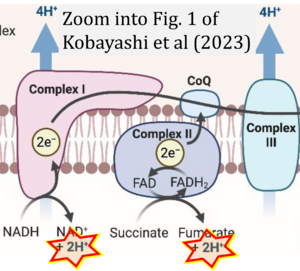Kobayashi 2023 Int J Mol Sci
| Kobayashi A, Takeiwa T, Ikeda K, Inoue S (2023) Roles of noncoding RNAs in regulation of mitochondrial electron transport chain and oxidative phosphorylation. Int J Mol Sci 24:9414. https://doi.org/10.3390/ijms24119414 |
Kobayashi A, Takeiwa T, Ikeda K, Inoue S (2023) Int J Mol Sci
Abstract: The mitochondrial electron transport chain (ETC) plays an essential role in energy production by inducing oxidative phosphorylation (OXPHOS) to drive numerous biochemical processes in eukaryotic cells. Disorders of ETC and OXPHOS systems are associated with mitochondria- and metabolism-related diseases, including cancers; thus, a comprehensive understanding of the regulatory mechanisms of ETC and OXPHOS systems is required. Recent studies have indicated that noncoding RNAs (ncRNAs) play key roles in mitochondrial functions; in particular, some ncRNAs have been shown to modulate ETC and OXPHOS systems. In this review, we introduce the emerging roles of ncRNAs, including microRNAs (miRNAs), transfer-RNA-derived fragments (tRFs), long ncRNAs (lncRNAs), and circular RNAs (circRNAs), in the mitochondrial ETC and OXPHOS regulation.
Hydrogen ion ambiguities in the electron transfer system
Communicated by Gnaiger E (2023-10-08) last update 2023-11-10
- Electron (e-) transfer linked to hydrogen ion (hydron; H+) transfer is a fundamental concept in the field of bioenergetics, critical for understanding redox-coupled energy transformations.
- However, the current literature contains inconsistencies regarding H+ formation on the negative side of bioenergetic membranes, such as the matrix side of the mitochondrial inner membrane, when NADH is oxidized during oxidative phosphorylation (OXPHOS). Ambiguities arise when examining the oxidation of NADH by respiratory Complex I or succinate by Complex II.
- Oxidation of NADH or succinate involves a two-electron transfer of 2{H++e-} to FMN or FAD, respectively. Figures indicating a single electron e- transferred from NADH or succinate lack accuracy.
- The oxidized NAD+ is distinguished from NAD indicating nicotinamide adenine dinucleotide independent of oxidation state.
- NADH + H+ → NAD+ +2{H++e-} is the oxidation half-reaction in this H+-linked electron transfer represented as 2{H++e-} (Gnaiger 2023). Putative H+ formation shown as NADH → NAD+ + H+ conflicts with chemiosmotic coupling stoichiometries between H+ translocation across the coupling membrane and electron transfer to oxygen. Ensuring clarity in this complex field is imperative to tackle the apparent ambiguity crisis and prevent confusion, particularly in light of the increasing number of interdisciplinary publications on bioenergetics concerning diagnostic and clinical applications of OXPHOS analysis.



